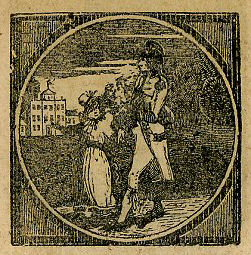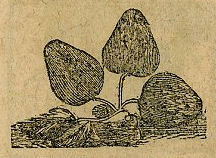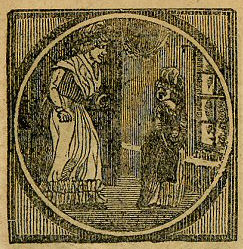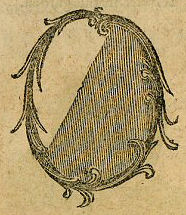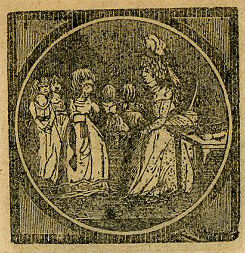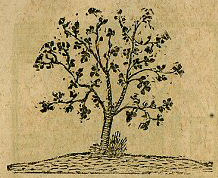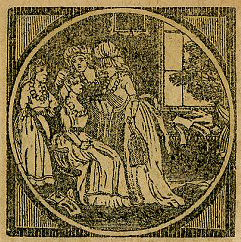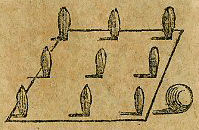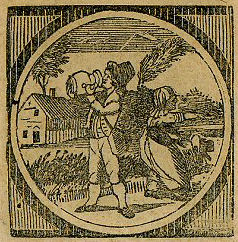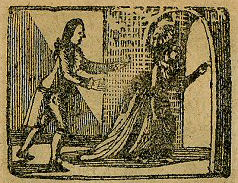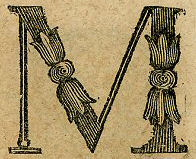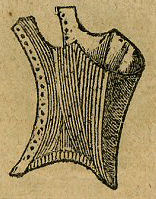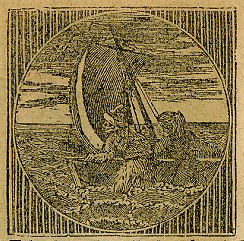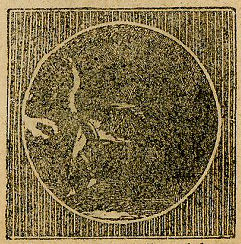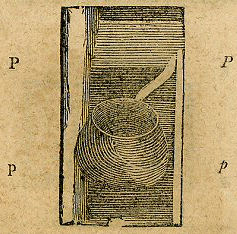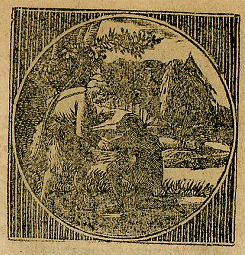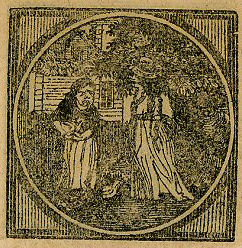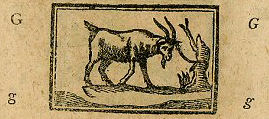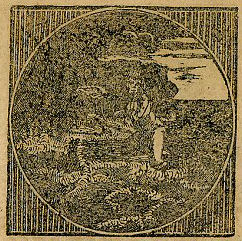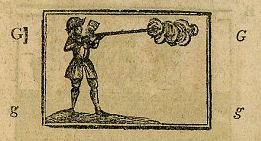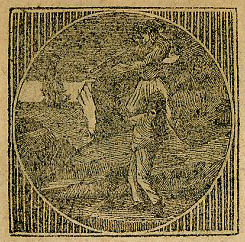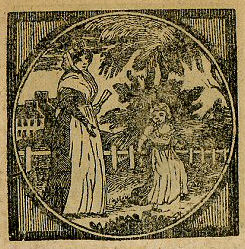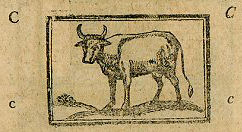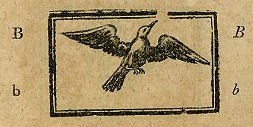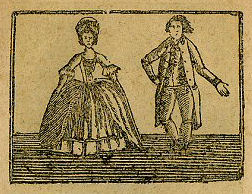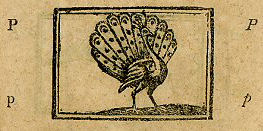A Picture Book, for Little Children (1811-1814)
When it comes to truth in title, A Picture Book, for Little Children
is hard to beat. It’s a book of pictures (45 of them), and thus probably
appealed to little children.
Today, this offbeat little charmer with its weird captions also appeals to
adults. It’s a good example of the way early publishers built a book by
setting a collection of illustrations into a matrix of text. The worn
cuts with their often misshapen people certainly weren’t created for this
publication. d’Alté Welch identified Robinson Crusoe and
Isaiah Thomas’s 1794 edition of Mother Goose’s Melody as sources
(A Bibliography of American Children’s Books Printed Prior to 1821,
number 993). A. S. W. Rosenbach credited Thomas’s 1795 edition of The
Brother’s Gift; or, The Naughty Girl Reformed for
another image (Early American Children’s Books,
number 466). Here they’ve been patched together into a chapbook with a
page size of about 2.5 inches wide and 5.5 inches high.
Whoever captioned the illustrations was probably doing a job he’d done all
too often, and doing it in a hurry. But the dry little statements make for
a book obliquely humorous. “We cannot see ourselves in this Glass,” reads
the caption for a picture of a mirror, and, no, we
certainly cannot. “What a curious figure she is!” reads
another, and that’s as apt a description as any. Few
turkeys have looked as bedraggled as
the one in this book; “perhaps she is not very well,”
the caption notes. Another appears to comment on the
indecipherable illustrations printed from worn blocks: “We cannot see well
at night;” and we truly cannot see what is going on in that illustration.
The last page seems to contain a lesson on vanity: “The
use of clothes is to cover us, and to keep us warm,” states the caption of an
illustration of a finely dressed man and woman; “what do these people wear
theirs for?” Probably, the writer seems to imply, not to keep warm. Below
them, a peacock “make[s] a great show with his fine feathers,” which is
appropriate, because “nature has given them”—unlike, perhaps, the couple
pictured above it.
The author also managed to include some local flavor:
“The Swedes Church” is at least the same shape as the
Gloria Dei—also called “Old Swedes’”—Church, built before 1700 in
Philadelphia. And the (upside-down) bible manages to
slip in an advertisement for the publisher, Kimber and Conrad.
When was this book created? It’s undated, and the recycled illustrations
show figures in 18th-century dress. Welch and Rosenbach give a date of about
1812. A copy in the online catalog of the American Antiquarian Society has a
guessed date of 1806. Kimber and Conrad had their bookstore at 93 Market
Street from 1809 to 1814, when they dissolved their partnership.
(See advertisements in Poulson’s American Daily Advertiser [30 May
1809]: 4 col 3 and [27 March 1811]: 1 col 4. “Dissolution of Partnership.”
American & Commercial Daily Advertiser [18 Jan 1815]: 1 col 3.)
Samuel Merritt apparently established his business as a printer in 1811 and
printed books for Kimber and Conrad from 1811 to 1814. (See Early American
Imprints.)
My copy is presented here in an illustrated transcription, with links to
images of the two-page spreads. For the sake of completeness, I’ve also
linked to images of the unprinted front and back covers.
http://www.merrycoz.org/books/pixbook/PIXBOOK.xhtml
A Picture Book, for Little Children. (Philadelphia: Kimber and Conrad, n. d.) Printed by Samuel Merritt
-----
[front cover]
-----
[title page]
A
PICTURE BOOK,
FOR
LITTLE CHILDREN.
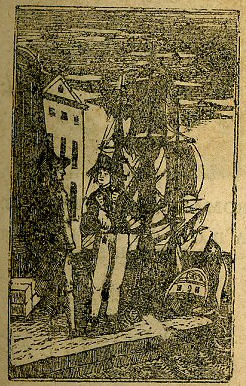 PHILADELPHIA:
PHILADELPHIA:
PUBLISHED BY KIMBER AND CONRAD,
NO. 93, MARKET STREET.
MERRITT, PRINTER.
-----
[page images]
[p. 2]
SMALL ROMAN LETTERS.
a b c d e f g h i j
k l m n o p q r
s t u v w
x y z &.
ITALIC LETTERS.
a b c d e f g h i j k
l m n o p q r s
t u v w x
y z &.
ROMAN CAPITAL LETTERS.
A B C D E F G H I J K L M
N O P Q R S T U V
W X Y Z.
ITALIC CAPITALS.
A B C D E F G H I J K L
M N O P Q R S T U V
W X Y Z.
DOUBLE LETTERS.
fi ff fl ffl ffi.
-----
[p. 3]
A walk in the garden.
Strawberries grow on little vines.
-----
[page images]
[p. 4]
What troubles the old woman?
We cannot see ourselves in this Glass.
-----
[p. 5]
Children obey your mother.
The Swedes Church.
-----
[page images]
[p. 6]
Do not rob the poor farmer of his fruit.
Some trees bear fruit, but this one has none on now.
-----
[p. 7]
-----
[page images]
[p. 8]
Do not drink too much.
She walks among the tombs.
-----
[p. 9]
Run fast, or she will be gone.
M. stands for Master, Mistress and Mother.
-----
[page images]
[p. 10]
What are they doing here?
The Cullender belongs to the kitchen.
-----
[p. 11]
Now Martha, do get up.
Give the Stays to Grandmother.
-----
[page images]
[p. 12]
Take down the sail when the wind blows too hard.
We cannot see well at night.
-----
[p. 13]
What a curious figure she is!
Water is boiled in a pot or in a kettle.
-----
[page images]
[p. 14]
Do be kind to the poor black boy.
A kite should never be raised in the street.
-----
[p. 15]
Walk in, and rest in the cottage.
This goat has horns and a beard—he seems to have
a mind to butt the old tree.
-----
[page images]
[p. 16]
Dogs are not often put to work—Drive on old man
and do not overset.
This is a trumpeter—he is in a great hurry—Stage
men and post riders sometimes blow a kind of trumpet.
-----
[p. 17]
It is difficult to travel where there is no road.
This turkey looks as if she had been in a shower
of rain—perhaps she is not very well.
-----
[page images]
[p. 18]
The bench looks pretty strong; perhaps it will not
break down.
It is good to be industrious—when our work is done,
we may have time to read.
-----
[p. 19]
Please to walk in, and take a seat by the fire and
warm yourselves.
This man shoots at random: he will kill no birds.
Little boys should not meddle with guns.
-----
[page images]
[p. 20]
A ship sails on the sea, it can be seen from the
rocks when a great way off.
Do not go far from the shore; the boat looks too
much like a tub to be a safe one.
-----
[p. 21]
It is not genteel to sit back to back—always look
at a person when you speak to him.
The bible is the best of all books. Children who can read
in the bible, may go to Kimber & Conrad’s Store and buy one for themselves.
-----
[page images]
[p. 22]
Old folks should never forget they were once young.
A cow is a useful creature; she gives us milk;
and butter and cheese are made of milk.
-----
[p. 23]
This poor man appears to be in distress—he has
thrown his axe upon the ground.
Little birds can fly very fast—They do no harm;
why should little boys delight to injure them?
-----
[page image]
[p. 24]
The use of clothes is to cover us, and to keep
us warm; what do these people wear theirs for?
A peacock can make a great show with his fine
feathers; but as nature has given them, let him show them.
-----
[back cover]

